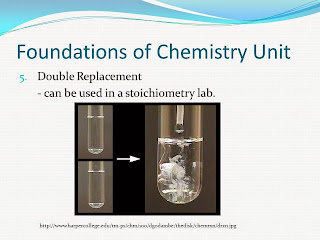Wednesday, 20 May 2015
Wednesday, 6 May 2015
Waves Labs
For the labs and activities in the Waves unit of Physical Science 20, I do a number of things:
1) Transverse & Longitudinal Waves Lab
- to study the transmission of these waves in a slinky
- to learn about fixed end and free end reflection
2) More Wave Properties
- to study and observe interference, periodic waves, refraction, and standing waves in a slinky
- to measure time and distance in order to determine frequency, period, wavelength and speed of standing waves
3) Images in a Concave Mirror Lab
- using an optical bench
- to learn how to find the focal point of a concave mirror
- to determine the patterns of image characteristics as an object approaches a concave mirror
- to introduce the mirror equation to students
4) Refraction of Light Lab
- using ray boxes and semi-circular blocks
- to observe refraction as light passes from air into a glass block and vice versa
- to determine Snell's Law
1) Transverse & Longitudinal Waves Lab
- to study the transmission of these waves in a slinky
- to learn about fixed end and free end reflection
2) More Wave Properties
- to study and observe interference, periodic waves, refraction, and standing waves in a slinky
- to measure time and distance in order to determine frequency, period, wavelength and speed of standing waves
3) Images in a Concave Mirror Lab
- using an optical bench
- to learn how to find the focal point of a concave mirror
- to determine the patterns of image characteristics as an object approaches a concave mirror
- to introduce the mirror equation to students
4) Refraction of Light Lab
- using ray boxes and semi-circular blocks
- to observe refraction as light passes from air into a glass block and vice versa
- to determine Snell's Law
Foundations of Chemistry Labs
My goals for grade 11 students doing chemistry labs in PS20 course are that they will be able to:
- measure mass using a balance
- measure volume by observing the meniscus
- light a Bunsen burner
- fold filter paper
In the labs and activities we do, they will develop these skills:
1) Types of Reactions Lab
– to observe 7 types of reactions and classify them.
- to write balanced equations and predict products
- learn to light a Bunsen burner
- measure volume by observing the meniscus
2) Counting by weighing activity
- to learn about the mole
- measure mass using a balance
3) Gravimetric Stoichiometry Lab
- to observe a double replacement reaction
- to perform a stoichiometric calculation using actual data
- to compare the result of the calculation to the original amount and calculate the percent difference, thereby determining the accuracy of the lab.
- measure mass using a balance
- fold filter paper
- measure volume by observing the meniscus
- measure mass using a balance
- measure volume by observing the meniscus
- light a Bunsen burner
- fold filter paper
In the labs and activities we do, they will develop these skills:
1) Types of Reactions Lab
– to observe 7 types of reactions and classify them.
- to write balanced equations and predict products
- learn to light a Bunsen burner
- measure volume by observing the meniscus
2) Counting by weighing activity
- to learn about the mole
- measure mass using a balance
3) Gravimetric Stoichiometry Lab
- to observe a double replacement reaction
- to perform a stoichiometric calculation using actual data
- to compare the result of the calculation to the original amount and calculate the percent difference, thereby determining the accuracy of the lab.
- measure mass using a balance
- fold filter paper
- measure volume by observing the meniscus
Heat Labs
In the heat unit I do several labs and activities:
1) Melting Ice Lab
- record temperature every two minutes as ice melts, the water heats up and the boiling point is reached
- using a Bunsen burner or a hot plate
- great for reviewing principles of graphing
- developing the idea of a warming curve for water
2) Cooling Water Lab
- record temperature every two minutes as 100 mL of water and 400 mL of water in beakers sit in an ice bath
- great for reviewing principles of graphing
- developing the idea of a warming curve for water
3) Specific Heat Capacity of Metals Lab
- to determine the specific heat capacity of iron, brass and aluminum metals by calorimetry
4) Expansion and Conduction lab activities
- using a kit from supply companies
- a set of three expansion activities and three conduction activities set up as six stations around the room
- includes a ball and ring apparatus, bi-metal strip, Leslie's cube, pyrometer, conductometer and metal conducting strips
5) Enthalpy of Solution for Ionic Solids Lab
- determine the heat involved in forming a solution of a small sample of four different solids
- using calorimeters
- two solids are exothermic when they dissolve, while two solids are endothermic as they dissolve
Subscribe to:
Posts (Atom)












